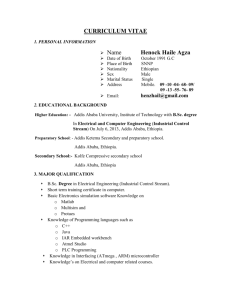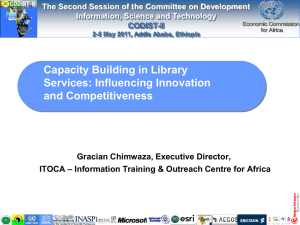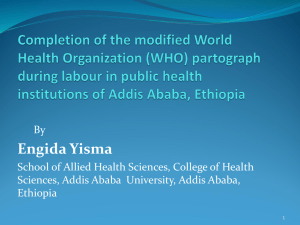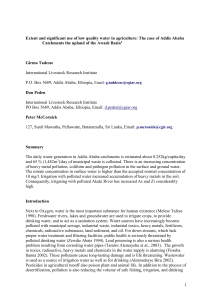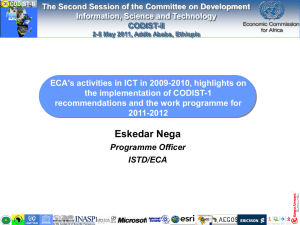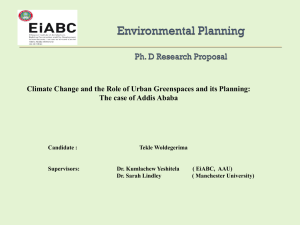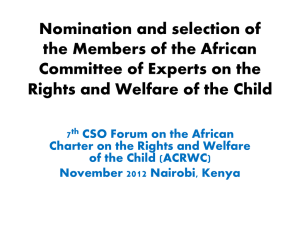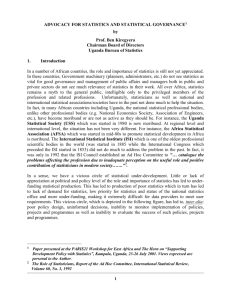Possibilities to Improve Dry Waste Management in Addis Ababa City
advertisement
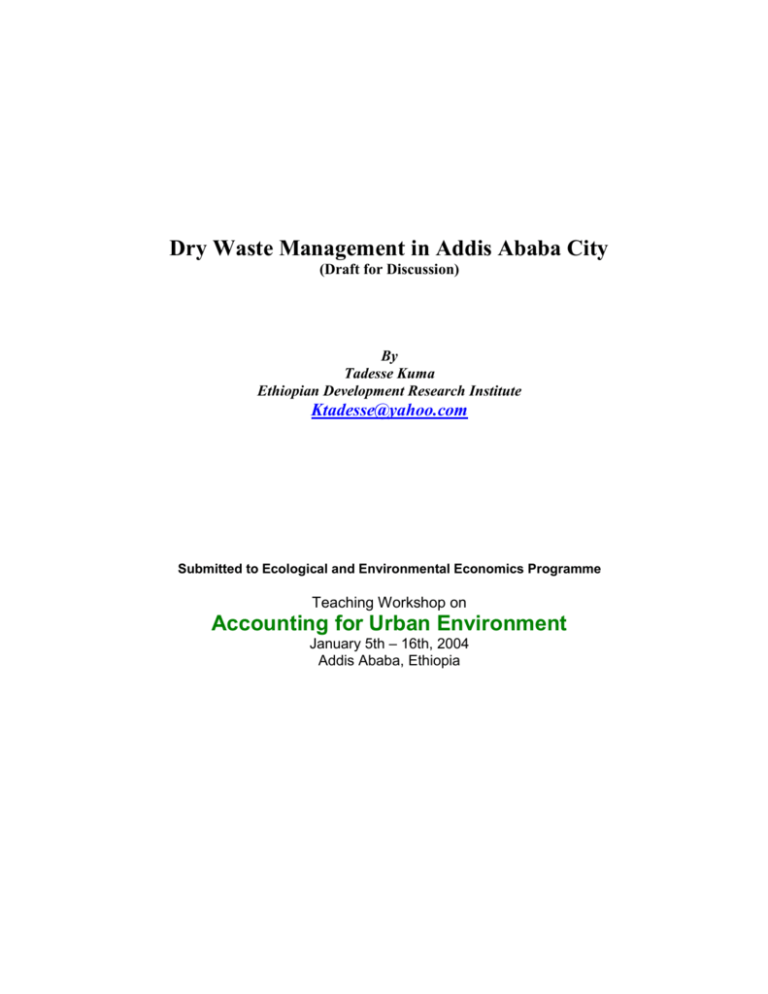
Dry Waste Management in Addis Ababa City (Draft for Discussion) By Tadesse Kuma Ethiopian Development Research Institute Ktadesse@yahoo.com Submitted to Ecological and Environmental Economics Programme Teaching Workshop on Accounting for Urban Environment January 5th – 16th, 2004 Addis Ababa, Ethiopia Abstract Like in many developing cities a rapid population growth and high rural-urban migration poses many environmental challenges for the Addis Ababa city. One of these is dry waste management. In adequate dry waste management has resulted in the accumulation of waste on open lands, in drains and in the living area of many people, causing a nuisance and foul-smelling pools, environmental pollution through leaches from piles (water and soil pollution) and burning of waste (air pollution), clogging of drains, and the possible spread of diseases. Unattended piles of waste are a breeding place for insects and rats. This situation is believed to result in poor environmental conditions and an ever-present risk of epidemics, which in turn present a formidable threat to health and productivity. There is thus a need for improved waste management. The present system of waste removal in Addis Ababa relies entirely on the municipality which is expected to provide the full range of waste collection and disposal. This is proving to be an impossible task, and except for privileged areas, the services offered are found to be largely inadequate. Even in the privileged area it accumulate for weeks. This approach neglects the many activities and actors that waste management comprise to tackle a range of problems associated with waste management in order to achieve socially and environmentally responsible waste management. Dry waste management may include legitimization of the informal system, community participation and possibly partial privatization. Such an integrated approach seems to be the best option and could well hold the key to effective and sustainable waste management system in developing cities such as Addis Ababa. This concept note for discussion tries to summaries causes for poor management of dry waste, role of community and private sector in DWM and suggest possible solutions as policy alternative. The concept note based on the Secondary sources of information. 1. Background Since Addis Ababa is the capital city of Ethiopia, enjoys a mid Afro-Alpine climate with an average temperature of 16C0, diplomatic capital for Africa (OAU, ECA), regional head quarters like UNDP, UNICEF, UNICEF, UNHCR, FAO,ILF, ICO, and ITU. The population of the city is 3035,135 live in 10 sub-cities1 and 204 kebels divided for administrative purpose. It is center for modern economic and social activities that infrastructure services are found relatively in better situation than other cities of Ethiopia. However their development is too slow to meet the demands of the increasing population due to both natural growth and rural urban migration. In particular, the complete inadequacy of the dry waste management is major environmental problem in Addis Ababa. The daily waste generation is estimated 0.252kg/capita/day. The current daily waste generation of the city is 2,297m3 or 851 tones. Of municipal waste per day, 65 % (1,482m3) is collected (Addis Ababa city SBPDA, 2003). The remaining 35per cent of waste is disposed off through informal means, except smaller percentage going to incineration and dumped on open sites, drainage channels, rivers and valleys as well as on the streets. The rivers are widely used as disposal sites. As simple observation around rivers bank indicates, large percentage of the uncontrolled waste goes to the rivers. Although the hygiene and environmental sanitation regulation issued by the Addis Ababa city administration (Pro.No.1,1994)prohibits people from disposing waste along roads, avenues, rivers, ponds, and other sites, the regulation is continuously violated by the people due to lack of alternative means for disposal. The rapid population growth rate of 3.8 per cent is also resulting in a rise of approximately 5 per cent of urban waste generation (Addis Ababa City Administration, 1998). This implies that if the current waste collection and disposal capacity is not matched with the growing generation. These environmental problems also have socio-economic consequences. Poor environmental quality of cities can deprive citizens of a good quality of life as it affects their health and consequently, adversely affect productivity and economic development (Geenhuizen and Van Nijkamp, 1995). Various concepts have been developed over the years to provide the basis for improving the solid waste conditions in developing countries. Among them, integrated dry waste management (DWM) provides a framework, which has been very successful in various countries. Inadequate municipal and industrial dry waste collection and disposal creates a range of environmental problems in Addis Ababa. A considerable amount of waste end up in open dumps or drainage system, threatening both surface water and ground water quality and causing flooding, which provides a breeding ground for diseases - carrying pests. Open air burning of waste, spontaneous combustion in landfills, and incinerating plants that lack effective treatment for gas emissions are causing air pollution. The situation is exacerbated in slums where households cannot make use of garbage collection containers. Lack of the most basic solid waste services in crowded, low-income neighbors is a major contributor to 1 . The ten sub-cities are: Addis Ketema, Lideta, Cherkos, Yeka, Bole, Akaki Kaliti, Nefas silk, Kolfe Keranio and Gulele each with an average population 300,000 the high morbidity and mortality among the urban poor. The adverse effect of inadequate solid waste service on productivity and economic development of the city expected to be significant. The present DWM system in Addis Ababa relies entirely on the municipality which is expected to provide the full range of waste collection and disposal. This is proving to be an impossible task, and except for privileged areas, the services offered are found to be largely inadequate. This approach neglects the many activities and actors that waste management comprises to tackle a range of problems associated with waste management in order to achieve socially and environmentally responsible waste management. An integrated approach to DWM seems to be the best option and could well hold the key to effective and sustainable waste management system in developing cities such as Addis Ababa. As effort to improve dry waste management, the city administration has transferred the service provision of dry waste management to the newly established Addis Ababa City Sanitation, Beatification and Park Development Agency (since January 2003), with objective to make the city naturally balanced, green and favorable environment through integrated management and urban recreational area development. The agency as part of future approach trying to establish and decentralize dry waste collection to 10 sub-city's dry waste management teams. This concept note for discussion tries to summaries causes for poor management of dry waste, role of community and private sector in DWM and suggest possible solutions as policy alternative. The concept note based on the Secondary sources of information. 2. Volume and Sources of Dry Waste According to Beyene (1991), in 1993 the per capita dry waste generation per annum was estimated to be 0.168567m3 In 1999, taking account of population growth alone, the annual waste generation is estimated to be 429, 146 m3. Based on the five-year work plan of the Region 14 administration, the total amount of waste to be collected per annum is set to be 65 per cent of the total volume generated in a year. If the plan materializes, 35 per cent uncollected every year. This demonstrates that despite of relative improvement in waste collection by employing more efficient means as planned, the volume of actual uncollected waste will continue to increase in proportion to the population. Any person while walking on the city from any corner all public spaces like road sides and open spaces attest eye-catching piles of garbage, flying 'festal' (which is increasingly used for packaging), rubbish, construction demolition and moved-earth from new construction sites littering the urban space indefinitely. Obnoxious odors emanating from decomposing solid wastes, semi-liquid and liquid waste are sickening all citizens. The city council recognizes six major sources of solid waste: households, street, commercial institutes, industries, hotels and hospitals. Available data for 1993 shows that households take the lion share of solid waste generated in the city. From total generated households 71%, street 10%, commercial institutions 9%, industries 6%, hotels 3% and hospitals 1%. A human excreta is the major area of concern even from the household wastes. In 1984 about 30% of the population of the city has no access to latrines. This proportion estimated to have only slightly fallen to 29.2 per cent in 1997 in relative terms. This means almost one-third of the population of the city has no latrines and experiences open defecation. Hence human excreta take proportionate share of the solid waste in the city. Moreover the available septic tanks used in the latrines usually overflows and pollute most of the older and overcrowded inner city with no short term solutions. The city administration has been making extensive efforts towards providing public laterins towards this end. Ash and smoke are other major components of waste originating from households. Apart from lighting, electricity has never been an important source of energy for the larger proportion of households. The study conducted by Beyene (1992) indicates that firewood, charcoal, dung cakes and other traditional bi-products are the major sources of energy for domestic use. For instance, the 1994 census result indicates that the domestic energy requirement of about 47 percent of housing units of the city is met from fire wood and leaves, charcoal, cow dung cakes and manure and combination of all these and kerosene. The amount of ash and smoke generated through combustion of these materials is immense. The other household waste worth consideration is "chat" which being increasingly used by most of the population of the city. It consumed as means of recreation by many people and serves as a stimulant. However, the increasing number of people using chat, its disposal in the ditches, open space and drainage systems liter the urban area and block the drainage systems to the determent of the environment and the health of population. Industrial waste is apparently insignificant In 1993 it account for 6 per cent of total volume of waste generated in the city. Although industrial solid wastes proportionately law, location factors and pollution control measures are yet to be adequately enforced. Although it is obvious that this particular instance has historical and economic reasons, its effect on the environment is undeniable. Landfill sites itself needs an attention. Landfill has impact on the surface and ground water. Decomposition of organic materials produces different gases, which has effect on the air above. Hence proper use of landfill requires certain standard including spreading refuse in the thin layers and compacting by bulldozer before next year spread. All measures meant to control contamination of surface and ground water as well as the air. Non of these practices are apparent in the landfill site of the city. Moreover, it is unprotected where children, destitute women and youngsters scavenging for survival. This also needs proper attention. The increasing problem of urban waste management has its roots in history. When the city was built as an administrative center in 1880s there was hardly any thought of waste as proportional threat. Never the settlement pattern, nor the mind setup of residents was in conformity with waste management issues. Thus the current problems are, at least in part, the cumulative effects of the historical development patterns of the city through the century and traditions of its people. With these features the expanse of the city space shows the immensity of the problem with high cost implications to ameliorate it. 3. Collections, Transportation and Disposal 3.1 Collection Municipal waste collection is handled in three ways: door-to-door collection for households along accessible streets; block collection for clients (large hotels, enterprises, and institutions) requesting the municipality to provide them with refuse containers; and containers system, which expects residents to carry and dump their waste in 8m3 refuse containers placed supposedly accessible sites. In practice 85 per cent of the waste is collected through the container system. Although the objective is to service every 2-3 days, containers are actually emptied in more than a week period on average. Besides, some households are located 1 km away from their closest container that people tend to through their waste in sewer and ditches. All solid waste collected by the municipality to single landfall, Repi dumping site, 40 years old (located south of the city) that is proved to be difficult to prevent scavengers from scratching through hazardous waste. The efficiency of this method is limited because of the capacity of the city council to deploy adequate number of vehicles and waste containers, which in tern has direct relationship with revenue generation of the city. Other waste disposal method such as composting of agricultural wastes, incineration and recycling of wastes are not used. Moreover the city council is mainly sole responsible for its management. Recently, 74 Micro and Small Enterprises (MSE) are engaged primarily collection from households to municipal container - improved collection of waste and created job for jobless youths. They charge 10-12 Birr/hhs/month. There are also 6 SMEs collecting and transporting. However, majority operates in the middle and high income areas. A recent study made by the Addis Ababa City Administration shows that the coverage has been constantly increasing from 38 percent in 1993 to 40 percent in 1994 and 53.9percent in 1996. The amount of waste generated in the city increased by 4 per cent (Hassen,1998). Generally in Addis Ababa, each keble (equivalent to neighborhood) has no more than two or three solid waste collection containers. According to 1994 population census, population of keble ranges 2500- 7031. According to Yami (1999), a single container shared by 14934 people which is 8 times higher than recommend by NUPI (one container for 2000). The settlement pattern of Addis Ababa is a spreading out, people need to travel long distance to use containers while the recommended distance by the same study is not to exceed 200mts. Besides, containers are not protected from rain and sun that makes the garbage to cause smell pollution, unsightly urban scene and deterioration of the neighborhood and disturbance of human activities. The site is also exposed for animals like dog, cat, and others during scavenging scatter the waste in the surrounding area. The situation in the newly developed parts of the city is not different. Solid waste disposal system not integrated with settlement development. 3.2 Transportation Out of 72 trucks, 35-40 work daily because of the average age of trucks more than 5 years, maintenance difficulties, negligence of drivers, frquent accidents during traffic congestation. The vehicles carry only a single container at a time to disposal site. A trip is made to and from collection sites only for single container of maximum capacity of 8m 3 or 2160kgs. Considering the cost of fuel, manpower and overhead costs for transportation per single trip that the system is inefficient and not economical. Some time the trucks have no cover for waste container and it distributed while travels to disposal site. 3.3 Disposal Reppi or "Koshe", the sanitary landfill located 13kms away from the city center. This site has been giving service since 1968. The present method of disposal is crude open dumping; hauling the wastes by truck, spreading and leveling by bulldozer and compacting by compactor bulldozer. The dumpsite is getting full, it is partly surrounded by residents and institutions and has no gas control. The gas generated from landfill causes spontaneous fire and air pollution.It contribute enormous amount of methane (green house gas) to the atmosphere. The site has low area capacity (25 ha), poor road connection. 4. Community and Private Sector involvement Considering the above stated components of DWM, increased participation of the private sector and community-based organizations seems to the direction for improved waste management in Addis Ababa. Addis Ababa municipality should be involved because they have ultimate responsibility for refuse collection; the private sector should be involved because they have a greater capacity to mobilize resources and run their operations on commercial and business principles (private sector involvement is not a new concept and it has been tried with varying success levels in a number of developing countries); and communities should be involved because as consumers of the service they have an obligation to pay for it or to make some other contribution that will ensure that the service is provided. In light of the above, it is essential to put forward a sound institutional arrangement for Addis Ababa municipality that involves community and private sector (including the partial privatization of collection service to contractors) in the city's DWM, as no single government agency acting alone, can not ensure comprehensive implementation and effectiveness. This collaboration can help ensure that each and every move fits into an integrated system designed for promoting public health, environmental protection, economic efficiency and good governance. Figure below shows the overall framework, although it is not intended to be an exhaustive list of categories. Essentially integrated DWM implies that decisions on waste handling should take into account environmental, economic and social dimensions (R. Gerlagh, et al., 1999). The integrative aspect lies in the trade-off between these three dimensions. For example, in certain situations, although recycling may be preferred from an environmental perspective, the economic costs involved or the presence of institutional complications may prevent waste recycling from being promoted and implemented in integrated DWM. The actual integration can take place at various levels (Lardinios and Klundert 1997). The use of a range of different collection and treatment options. These include prevention, recycling, energy recovery and sound landfilling of solid waste. The involvement and participation of all the stakeholders. These may include waste processors such as formal and informal recyclers, waste generators such as households, industry and agriculture, and government institutions such as waste managers and urban planners. Framework for analyzing the concept of Integrated DWM Stakeholders - government - waste processors - waste generators Management Options - prevention - recycling - disposal Integrated DWM - economic dimension - environment dimension - social dimension - institutional dimension Driving Forces - income - population - attitude - technology - climate Source: Dawit & Yemeserach It is difficult to include all these aspects at the same time, since the factors affecting solid waste management are constantly changing. For example, income and population growth contribute significantly to the amount of waste which has to be managed. Similarly, differences in educational background and environmental awareness results in varying attitudes of waste generators. Finally, technological progress in the field of waste management is rapid, so certain technologies may outdate more rapidly. In general, the main problems in DWM includes the geographical and urban structure of Addis Ababa makes most parts of the city inaccessible, the poor socio-economic status of population, lack of properly designed root system and time schedule, containers are not properly collected and emptied when full, insufficiency of fund for and absence of cost recovery, poor track maintenance and so on. Thus this poor management has economic and social effects on the citizens unless handled appropriately through collaborative scheme where city administration, private sector, community and NGOs play their parts separately and/or as a group. 5. Conclusions and Policy Recommendation As discussed above, though various studies and programs are undertaken to curtail the problem of dry waste, the service still fall a short of required level. The points discussed below are forwarded for improvement of the services. The provision of solid waste management at present is responsibility of municipalities. The efforts by NGOs, the private sector, and community very low. The private sector role is very limited because of lack of attractive mechanisms designed to accommodate, manage and integrate partnership and cooperation. Some activities can be carried out by the private sector with reduced costs. Provision of incentives for private waste collectors; give legal procedures which impose users charges on the sources and enforcing restrictions on disposing wastes on unauthorized spaces and encourage private entrepreneurs in recycling; Raise public awareness not only on the importance of creating healthy environment but also on the mechanisms of controlling generation of waste at the source, alternative disposal mechanisms and share of responsibilities between the general public, local and traditional institutions, business community, non-government and governmental institutions through regular campaign, education and training programs at the neighborhoods, health institutions and workplaces. Educating women should be given the highest priority since in the Ethiopian society, cleanness of the family, housing units and immediate surroundings is responsibility of the women. Set up functional municipal structures at grassroots levels both to work with the communities and traditional institutions like 'edir' in educating the public on controlling generation of solid waste and its disposal as well as enforcing regulations enacted by the regional government. Establish additional waste disposal facilities like landfill sites and incineration facilities in all direction at accessible sites depending on the rate of solid waste generation. Additional trucks with large capacity - in order to raise efficiency and reduce number of trips and place refuse containers in the easily accessible areas. As commercial fuels are costly for low-income households, promote energy saving appropriate technologies through various means to minimize the biomass used for energy generation and hence ash and related waste production. . The Way forward The following are some of the major key areas to attain desired results: Decentralization of full responsibilities and authorities of DWM to sub-city level and build their capacity, support through training; Improving collection and transportation: optimizing trucks rotation, improve truck maintenance; Rehabilitation of the existing landfill and intiate acton to build atleast one new landfill; Designing ways to encourage private sector investment/participation; Promote waste segregation at the source, waste minimization, recycling, ruse, recovery and composting; Institutionalize public participation in DWM; Promote cost recovery and rationalize the public finance Strict compliance of existing rules and regulation on the dumping and littering the environment References Addis Ababa City Administration 1998 '' Improving Urban Environmental conditions in Addis Ababa'' Addis Ababa Ethiopia Addis Ababa city Sanitation, Beautification and Park Development Agency, 2003. Status of Dry waste management in the city. Draft report Addis Ababa City SBPDA, 2003. Dry waste management legislation and regulation ..approved. Beyene Geleta, (1999). Managing Solid Waste in Addis Ababa paper presented in the Integrated Development for Water Supply and Sanitation'', Addis Ababa, 1999 Camell de Stoop 1998 '' Waste collection and Disposal in Addis Ababa'' Proceedings work shop held in Addis Ababa, The Royal Netherlands Embassy. Dawit Walelegne and Yemeserach Assefa, 2001. Improvement of Solid Waste Management in Addis Ababa: A Participatory Approach, Draft work Gerlagh, R., Pieter Van B., Verma, M, Yadav, P.P. and Pendey, P. 1999 ''Intergrated Modeling of Solid Waste in India '',Working Paper No 26 The world Bank, Washington, DC Heidenstam, O. von. 1977. "Swedish Experience in Separation at Source Solid Wastes." Institute of Solid Waste Management, London Huysman, Marijk. 1994. "The position of waste pickers in solid waste management in bangalore". In Isa Baud and Hans Huysman (eds) Solid Waste Management: Modes, Assessments, Appraisals and Linkages in Bangalore, Manohar Publishers, New Delhi Klundert, A. van de and I. Lardinois 1995 "Community and private (formal and informal) sector involvement in municipal solid waste management in developing countries:" background paper for the UMP workshop in Ittingen 10-12 April 1995. Gouda: Waste Yami Birke, (1999). Solid Waste Management in Ethiopia- paper presented in the Integrated Development for Water Supply and Sanitation'', Addis Ababa, 1999 World Bank. 1995. Workers in an Integrated World: World Development Report,1995. Oxford University Press, New York.
